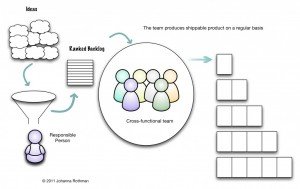Iterations and Increments
Agile is iterative and incremental development and frequent delivery with cultural change for transparency.
What do the words iterative and incremental mean?
Iterative means we take a one-piece-at-a-time for creating an entire feature. Iterative approaches manage the technical risk. We learn about the risk as we iterate through the entire feature set.
Incremental means we deliver those pieces of value. Incremental approaches manage the schedule risk, because we deliver finished work.
Agile works because we manage both technical and schedule risk. We iterate over a feature set, delivering chunks of value. (One reason to deliver value often is so we can change what the team does next.)
Here’s a way to think about this if I use a feature set called “secure login.” Now, no one wants to log in. But, people want to have security for payment. So secure login might be a way to get to secure payment. The theme, or what I have been calling a feature set, is “Secure login.” A feature set is several related features that deliver a theme.
If you want to iterate on the feature set, you might deliver these valuable increments (I first wrote about this in How to Use Continuous Planning):
- Already existing user can log in.
- Users can change their password.
- Add new user as a user.
- Add new user as admin.
- Prevent unwanted users from logging in: bots, certain IP addresses, or a physical location. (This is three separate stories.)
If you implement the first story, you can use a flat file. You can still use a flat file for the second story. Once you start to add more than 10 users, you might want to move to some sort of database. That would be a story. It’s not “Create a database.” The story is “Explore options for how to add 10, 100, 1000, 10000 users to our site so we can see what the performance and reliability implications are.”
Notice the explore as part of the story. That would lead to a spike to generate options that the team can discuss with the PO. Some options have performance implications.
Every time the team iterates over the feature set, they deliver an increment. Since many teams use timeboxes, they use “iterations” as the timebox. (If you use Scrum, you use sprints.) Notice the term “iterate over the feature set.”
In incremental life cycles, such as staged delivery, the team would finish all the features in the one feature set. Incremental life cycles did not necessarily use timeboxes to timebox the incremental development. In iterative life cycles, such as spiral or RUP, the team would develop prototypes of features, or even partially finish features, but the final integration and test occurs after all the iterative development was done.
In agile, we iterate over a feature set, delivering incremental value. If you don’t finish your stories, you’re in an iterative life cycle. If you don’t limit the features you finish and finish “all” of them, you are in an incremental life cycle.
There is No One Right Way to select a life cycle for your project. If you want to use agile, you iterate over a feature set in a short time, delivering chunks of value.
If you are having trouble slicing your stories so you can create feature sets, see my Product Owner Workshop (starting in January). Super early bird expires this coming Friday.
| Reference: | Iterations and Increments from our JCG partner Johanna Rothman at the Managing Product Development blog. |



